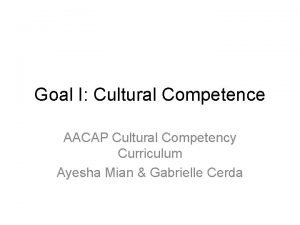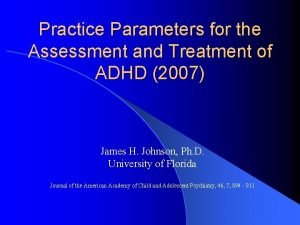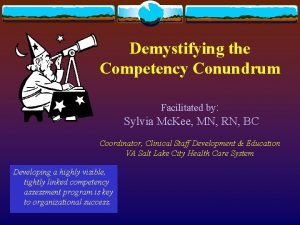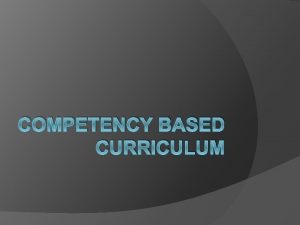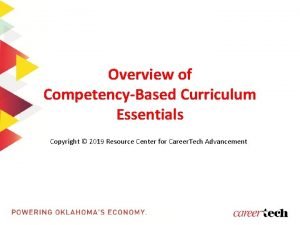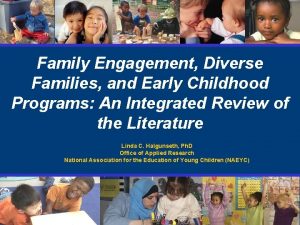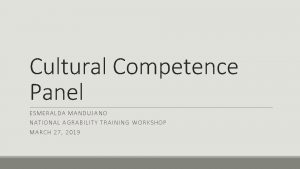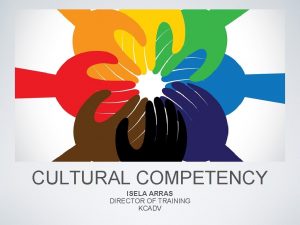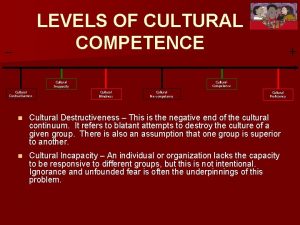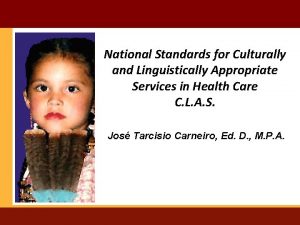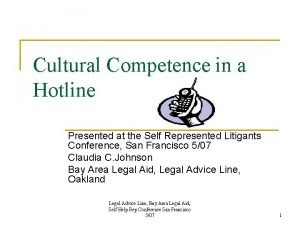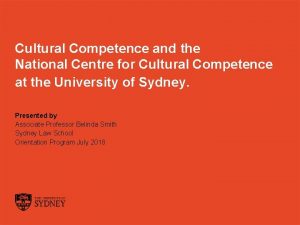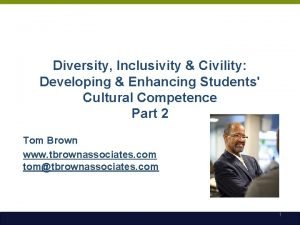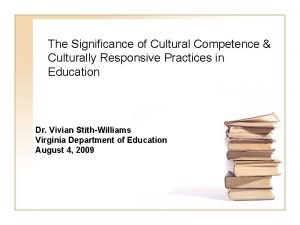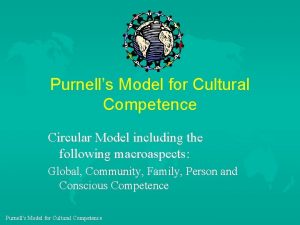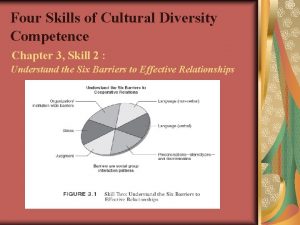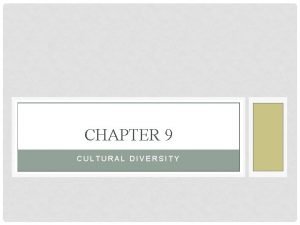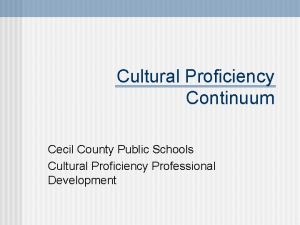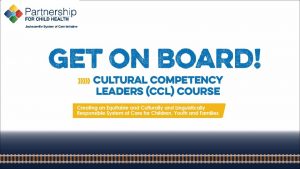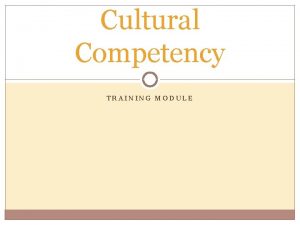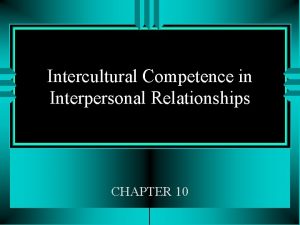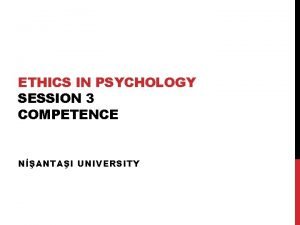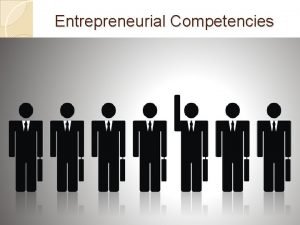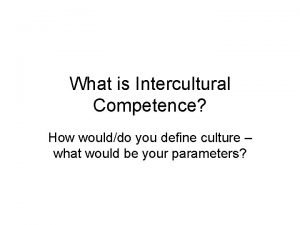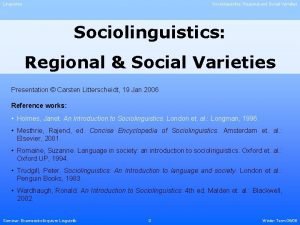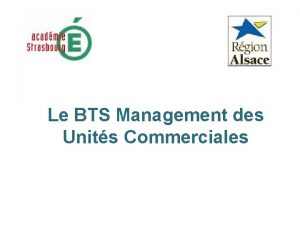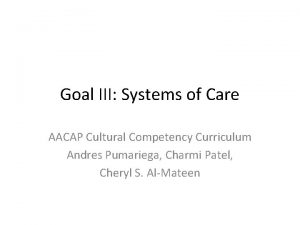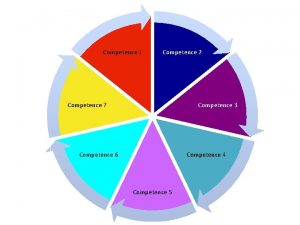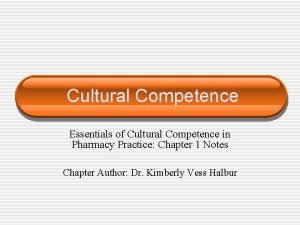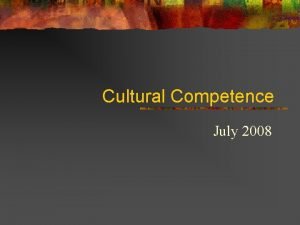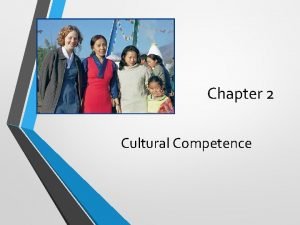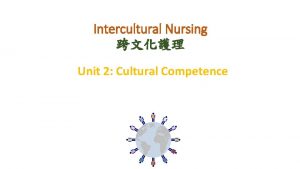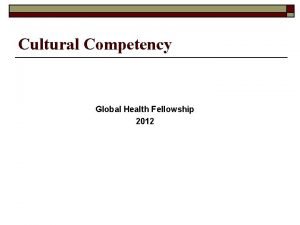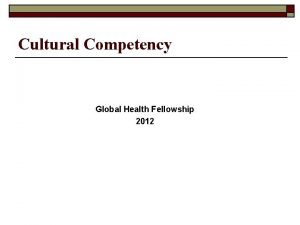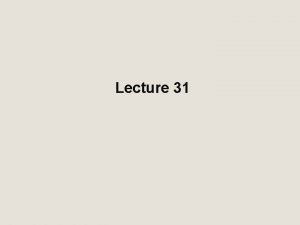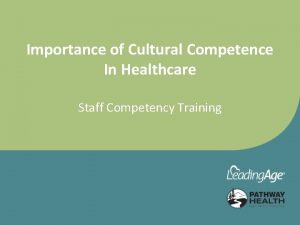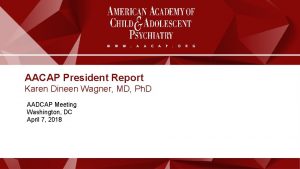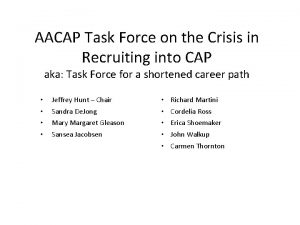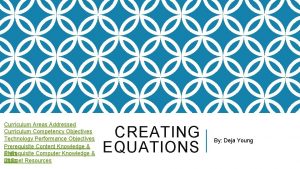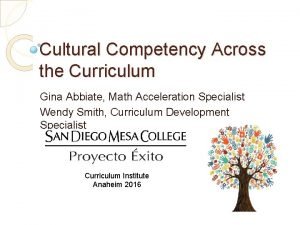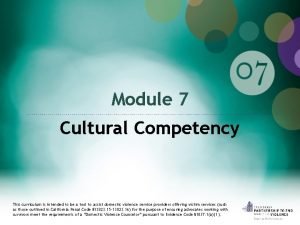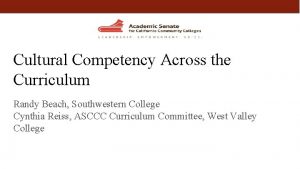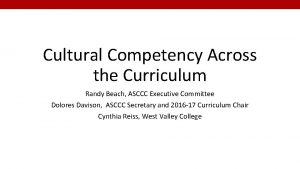Goal I Cultural Competence AACAP Cultural Competency Curriculum




























- Slides: 28

Goal I: Cultural Competence AACAP Cultural Competency Curriculum Ayesha Mian & Gabrielle Cerda

Historical Perspective • Cultural psychiatry > 100 years (“unusual syndromes” by Western standards) • Limited focus to “exotic” • Not incorporate cultural eval into mainstream • 1994 DSM-IV Appendix I—”Cult Formulation” – Framework to assess impact of culture on mental illness

Relevance of Culture • Culture shapes – which sx are expressed – how they are expressed • Culture influences – meaning given to sx – what society deems appropriate or inappropriate – conceptualization & rationale of psychiatric diagnostic categories/ groupings – matrix for clinician-pt exchange

Culture Defined Many Ways • Set of shared norms, beliefs, meanings, values • Dynamic, evolves over time with generations • Terms usable & relevant to mental health • Cultural identity > ethnicity/ race – Occupation – Sexual orientation --Age gender --Spirituality/ religion

Essential Components of Culture • • • Learned Refers to system of meanings Acts as shaping template Taught and reproduced Exists in constant state of change Includes patterns of both subjective & objective components of human behavior • Gaw 2001

Cultural Assessment: Advantages • Clinician more informed on pt perspective • Assist rapport—care about whole person, not just illness • Identify areas that impede/ strengthen tx • Potential cultural conflicts for pt – Identity (parent v. child) – Traditional v. mainstream expectations (parenting role)

Outline For Cultural Formulation • Cultural identity of individual – What does belonging in that group mean to pt • Cultural explanation of illness – Often somatic—only Western separate mind-body • Psychosocial environment/ level of fn – Intergenerational conflicts • Therapeutic relationship – Clinician/ child/ parent • Overall cultural assessment for dx/ care – Accepting/ dynamic attitude to new info/cont monitor

Cultural Identity • • Ethnicity Race Country of origin Language Gender Age Marital status Religious/ spiritual beliefs • SES • Education • Other identified groups • Sexual orientation • Migration history • Level of acculturation

Acculturation Process • • Active v. passive From external sources v. individual Solitary endeavor or do others participate with pt Process constant v. intermittent Subtle v. dramatic or in-between Attitude about acculturation: indiv v. others Vision re: where new cult elements take him Fully adopt new culture = assimilated/ integration

Migration History • Pre-migration history – Country of origin/Family/ education – SES/ community & family support/ political • Experience of migration – Migrant v. refugee/ why left? / who left behind? – Who paid for trip? / means of escape/ trauma • Degree of loss – Loss family members/material losses/ career/community & family support

Migration History • Traumatic experience – Physical: torture/ starvation/ imprisonment – Mental: rage/ depression/ guilt/ grief/ PTSD • Work and financial history – Original work/ current work/ SES • Support systems – Community/ religion/ family

Migration History • Medical history – Beliefs herbal medicine/ somatic complaints • Family’s concept of illness – What do family members think is problem/ cause/cure? Expected result? • Level of acculturation – Generation? Differences among family members? • Impact on development—level of adjustment

Explanatory Models • Moral – Moral defect: lazy, selfish, weak will – Try fix character flaw: “just have to work harder” • Spiritual/ religious – Transgressions—”angered higher power” – Interventions—atonement/ religious leader • Magical – Hex/ sorcery/ witchcraft – find person caused/ healer

Explanatory Models • Medical—biological model – Western – non-Western • Homeopathic, traditional Chinese, • Herbal medicine, osteopathic • Psychosocial stress – Illness due to overwhelming stress – Treatment targets stressors

Conflicting Explanatory Models • Patient- provider – Decr rapport/tx non-adherence/ tx dropout • Patient- family – Lack support/shame/ family discord • Patient- community – Social isolation/ stigmatization

Cultural Explanations of Illness – Symptoms – Severity – Course of presentation – Precipitants & explanations – Treatment – Experiences with help seeking – Type of treatment pt/ family wants now

Psychosocial Environment • Cultural factors related to psychosocial environment & levels of functioning – Stressors & supports • Individual • Family/ community • Environment

Psychosocial Environment – Assessing psychosocial enviroment & functioning • • Partner/ parent support Partner/ parent stressors Family support Family stressors Community support Community stressors Religion/spirituality Functioning

Therapeutic Relationship • Cultural elements of relationship between individual & clinician – Own cultural background – Patient’s cultural identity – Parent’s cultural identity – Move from categorical approach – Ongoing assessment – Transference/ counter-transference – Consider cultural consult – Patient’s motivation for treatment

Therapeutic Relationship • Provider’s cultural identity & culture of mental health tx can significantly impact patient care • Influence many aspects of delivery of care – Diagnosis/Treatment – Organization/ reimbursement • Issues that arise from cultural conflicts • Pitfalls of assessment tools • Appropriate use interpreters/ cultural consultant

Interpreters • Verbal/ non-verbal communication • Types interpretation – Verbatim – Summary – Cultural • 3 phases interpreted interview – Pre-interview – Interview – Post-interview

Assessment Tools • Normed on ethnic minorities? • Translation not sufficient – Languages have different • Meanings • Connotations • Idioms of expression • Rating scales may be used if – Translated/ back-translated/ validated

Clinician’s Role • Clinicians who have clarity about their own – Cultural identity – Role in mental health treatment • Better position to anticipate problematic cultural dynamics of clinical exchange – Decrease negative outcomes – Enhance positive outcomes

Therapeutic Relationship • Interethnic Transference – Patient’s response to an ethno-culturally different clinician • Interethnic Counter-transference – Ethno-culturally different clinician may respond in non-therapeutic manner – Denial of cultural influence on clinical encounter

Cultural Influences On Transference Interethnic effects Intraethnic effects • • • Omniscient-omnipotent therapist • The traitor • Autoracism • ambivalence Overcompliance Deny ethnocultural factors Mistrust Hostility ambivalence

Cultural Influences On Counter-transference Interethnic effects • Deny ethnocultural factors • Clinical anthropologist syndrome • Guilt or pity • Aggression • Ambivalence Intra-ethnic effects • Over-identification • Distancing • Cultural myopia • Ambivalence • Anger • Survivor’s guilt

Overall Assessment • Overall cultural assessment for dx & care – Make differential diagnosis – Formulate case narrative including cult factors – How will cultural formulation affect managmnt • Language • Patient/Parents/ Family • Treatment approach » Engagement » Adherence

Case: Cultural Formulation • • • Cultural identity of individual Cultural explanation of illness Psychosocial environment Therapeutic relationship Overall cultural assessment for dx/care
 Aacap
Aacap Aacap practice parameters
Aacap practice parameters Competence vs competency
Competence vs competency Budaya organisasi adalah
Budaya organisasi adalah Rationale of competency based curriculum
Rationale of competency based curriculum Competency based curriculum
Competency based curriculum Naeyc pathways to cultural competence checklist
Naeyc pathways to cultural competence checklist Cultural competence
Cultural competence Cultural competence on resume
Cultural competence on resume Kcadv certification
Kcadv certification Cultural pre competence
Cultural pre competence Cultural competence staircase
Cultural competence staircase Cultural competence
Cultural competence National centre for cultural competence
National centre for cultural competence Nea cultural competence
Nea cultural competence Understanding civility and cultural competence
Understanding civility and cultural competence Cultural competence
Cultural competence Purnell's model for cultural competence
Purnell's model for cultural competence Four skills of cultural diversity competence
Four skills of cultural diversity competence Chapter 9 cultural diversity
Chapter 9 cultural diversity Cultural proficiency continuum examples
Cultural proficiency continuum examples Terry cross cultural competence
Terry cross cultural competence Cultural competency training modules
Cultural competency training modules Interpersonal communication competence requires
Interpersonal communication competence requires Boundaries of competence
Boundaries of competence Enterprise management competencies
Enterprise management competencies Define intercultural competence
Define intercultural competence Example of sociolinguistic competence
Example of sociolinguistic competence Bts muc en quoi ça consiste
Bts muc en quoi ça consiste
